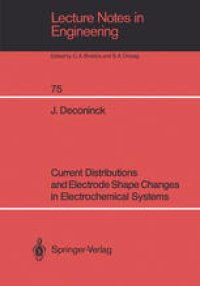
Ebook: Current Distributions and Electrode Shape Changes in Electrochemical Systems
Author: Dr. Johan Deconinck (auth.)
- Tags: Appl.Mathematics/Computational Methods of Engineering, Industrial Chemistry/Chemical Engineering, Electrical Engineering
- Series: Lecture Notes in Engineering 75
- Year: 1992
- Publisher: Springer-Verlag Berlin Heidelberg
- Edition: 1
- Language: English
- pdf
This book reponds to the increasing demand of computer mo- delling of electrochemical processes in order to improve their speed and efficiency. The fundamental transport equa- tions in dilute solutions are given and it is established in detail under what circumstances a potential model with non- linear boundary conditions, involved by electrode reactions, can beused. Attention is directed towards the most impor- tant solution techniquesFEM, FDM and BEM and towards the solution of the non-linear system of equations (Successive Substitution, Newton-Raphson). Using the BEM, several two- dimensional and axisymmetrical examples of current density distributions are given and quantitative data, obtained in a copper electro-refining cell, are compared with calculated results. Applying Faraday's Law and the BEM, simulation of electro-deposition, electro-chemical levelling and machining are treated. Accuracy and stabilityare emphasized.
This book reponds to the increasing demand of computer mo- delling of electrochemical processes in order to improve their speed and efficiency. The fundamental transport equa- tions in dilute solutions are given and it is established in detail under what circumstances a potential model with non- linear boundary conditions, involved by electrode reactions, can beused. Attention is directed towards the most impor- tant solution techniquesFEM, FDM and BEM and towards the solution of the non-linear system of equations (Successive Substitution, Newton-Raphson). Using the BEM, several two- dimensional and axisymmetrical examples of current density distributions are given and quantitative data, obtained in a copper electro-refining cell, are compared with calculated results. Applying Faraday's Law and the BEM, simulation of electro-deposition, electro-chemical levelling and machining are treated. Accuracy and stabilityare emphasized.
Content:
Front Matter....Pages N2-XV
The Current Distribution in Electrochemical Systems....Pages 1-55
Solution of the Potential Model....Pages 56-93
The Boundary Element Method to Solve Current Distributions....Pages 94-163
Electrode Shape Change....Pages 164-220
General Conclusion....Pages 221-223
Back Matter....Pages 224-283
This book reponds to the increasing demand of computer mo- delling of electrochemical processes in order to improve their speed and efficiency. The fundamental transport equa- tions in dilute solutions are given and it is established in detail under what circumstances a potential model with non- linear boundary conditions, involved by electrode reactions, can beused. Attention is directed towards the most impor- tant solution techniquesFEM, FDM and BEM and towards the solution of the non-linear system of equations (Successive Substitution, Newton-Raphson). Using the BEM, several two- dimensional and axisymmetrical examples of current density distributions are given and quantitative data, obtained in a copper electro-refining cell, are compared with calculated results. Applying Faraday's Law and the BEM, simulation of electro-deposition, electro-chemical levelling and machining are treated. Accuracy and stabilityare emphasized.
Content:
Front Matter....Pages N2-XV
The Current Distribution in Electrochemical Systems....Pages 1-55
Solution of the Potential Model....Pages 56-93
The Boundary Element Method to Solve Current Distributions....Pages 94-163
Electrode Shape Change....Pages 164-220
General Conclusion....Pages 221-223
Back Matter....Pages 224-283
....
This book reponds to the increasing demand of computer mo- delling of electrochemical processes in order to improve their speed and efficiency. The fundamental transport equa- tions in dilute solutions are given and it is established in detail under what circumstances a potential model with non- linear boundary conditions, involved by electrode reactions, can beused. Attention is directed towards the most impor- tant solution techniquesFEM, FDM and BEM and towards the solution of the non-linear system of equations (Successive Substitution, Newton-Raphson). Using the BEM, several two- dimensional and axisymmetrical examples of current density distributions are given and quantitative data, obtained in a copper electro-refining cell, are compared with calculated results. Applying Faraday's Law and the BEM, simulation of electro-deposition, electro-chemical levelling and machining are treated. Accuracy and stabilityare emphasized.
Content:
Front Matter....Pages N2-XV
The Current Distribution in Electrochemical Systems....Pages 1-55
Solution of the Potential Model....Pages 56-93
The Boundary Element Method to Solve Current Distributions....Pages 94-163
Electrode Shape Change....Pages 164-220
General Conclusion....Pages 221-223
Back Matter....Pages 224-283
This book reponds to the increasing demand of computer mo- delling of electrochemical processes in order to improve their speed and efficiency. The fundamental transport equa- tions in dilute solutions are given and it is established in detail under what circumstances a potential model with non- linear boundary conditions, involved by electrode reactions, can beused. Attention is directed towards the most impor- tant solution techniquesFEM, FDM and BEM and towards the solution of the non-linear system of equations (Successive Substitution, Newton-Raphson). Using the BEM, several two- dimensional and axisymmetrical examples of current density distributions are given and quantitative data, obtained in a copper electro-refining cell, are compared with calculated results. Applying Faraday's Law and the BEM, simulation of electro-deposition, electro-chemical levelling and machining are treated. Accuracy and stabilityare emphasized.
Content:
Front Matter....Pages N2-XV
The Current Distribution in Electrochemical Systems....Pages 1-55
Solution of the Potential Model....Pages 56-93
The Boundary Element Method to Solve Current Distributions....Pages 94-163
Electrode Shape Change....Pages 164-220
General Conclusion....Pages 221-223
Back Matter....Pages 224-283
....
Download the book Current Distributions and Electrode Shape Changes in Electrochemical Systems for free or read online
Continue reading on any device:

Last viewed books
Related books
{related-news}
Comments (0)